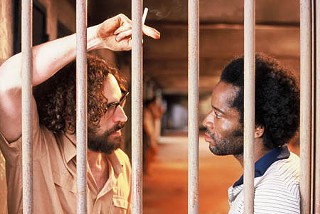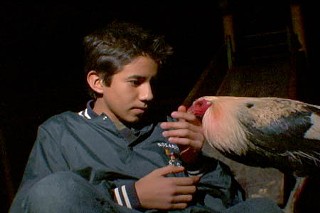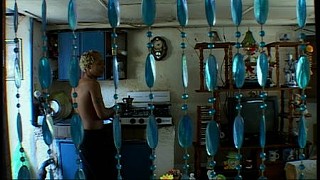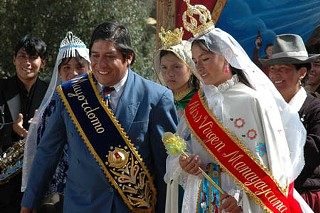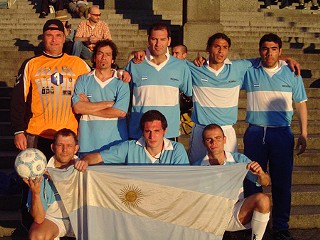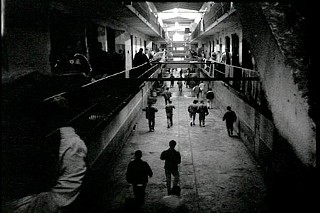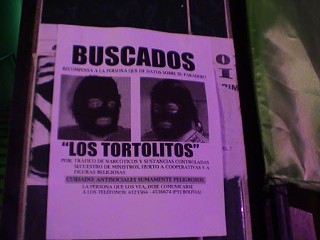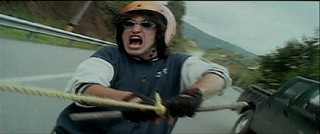Travelogue
Exploring and exploding borders with Cine las Americas
Fri., April 20, 2007
For more information or to buy passes, see www.cinelasamericas.org. For previews, a schedule, and a spotlight on the films of the festival's guest of honor, Lúcia Murat, read on.
En El Hoyo (In The Pit)
D: Juan Carlos Rulfo
What first appears to be a slice-of-life look at construction workers elegantly evolves into a moving testament to the price paid for the creation of a city. Mexico City's massive Periférico freeway project (similar to Austin's new flyovers) is the film's backdrop. The seemingly interminable project has snarled traffic and irritated residents for years. As En el Hoyo progresses, the project becomes more than an annoying construction zone but a reminder of how human sweat provides the mortar for a city. For some, the sacrifice is larger. According to Mexican legend, the devil demands at least one soul during the construction of a bridge to assure its stability. The Periférico project has seen its share of lost souls through on-site accidents and the daily grind that exploits the spirit as well as the body. En el Hoyo is no overwrought paean to the workingman. Rulfo presents his characters with candor and dignity. When the film occasionally steps back to reveal the Periférico's progress, En el Hoyo simply dazzles. A renewed awe is elicited at the existence of behemoth structures, making them less likely to fade into the periphery, especially when the flesh-and-blood price is made visible. – Belinda Acosta
36 Pasos (36 Steps)
D: Adrián García Bogliano; with Noelia Balbo, Ines Sbarra, Melisa Fernandez, Ariana Marchioni, Priscila Rauto
Gorehounds, asshounds: Run, don't walk, to this budget-conscious and kooky but surprisingly effective slasher flick from the director of Habitaciones Para Turistas (Rooms for Tourists), an Argentine favorite from 2005's festival. Bogliano layers familiar horror motifs with a critique of women's oppression, albeit one accompanied by gynecologically intimate low angles of half-wedgied bikini bottoms and all manner of graphic violence: strobe-lit torture montages, branding, and a choreographed dance sequence. Bogliano's girls frolic in the garden hose in winking slo-mo sequences, but soon enough we see that in their poolside vacation house they are kept captive like Troma babes in a pervy zoo exhibit. The rules – silence, obedience, and happiness – are enforced by a club-wielding, 300-pound man-boy who chops off fingers. Having thus inculpated the voyeuristic, sadistic, and presumably male gaze of his audience, Bogliano cranks up the camp, speeding toward a splatter finale competently stylized after the pulpy mayhem of giallo and "killer party" slashers like My Bloody Valentine. Let's not call it feminist, but there is something recognizably anti-patriarchal and satirical in the way the women are trained to a whistle and forced to smile and act nice, then pitted against one another for survival. – Marrit Ingman
Diario de Naná (Naná's Diary)
D: Paschoal Samora
"Samba is life," Dalva exclaims as she throws her aged body into the rapid rhythm of her "Jiló." Dalva is but one of the blessed souls Naná Vasconcelos encounters on his quest to find "the music of the sacred and the sacred of the music." A Brazilian percussionist, Naná sees with his ears. He feels, smells, and touches with an aural capability that most skim right over. The train passing by becomes a beat. The waves beckon him forward and back. Naná's Diary is a poem to the real Brazilian music, that which melded African and Arab and turned it into something singular and encompassing. Naná waits for a gourd to call out to him to attach to his berimbau. He eats coconut ice cream on a dock with the poet Antonio Vieira, who has a voice like a white-noise hum. He runs with peacocks and searches for dishes, all with his ear turned toward the crowd and back again. From Salvador through the sugar plantations of Cachoeira in the ancient Recôncavo Baiano, Naná introduces the next generation, and the future, to the roots of primitive rhythm while director Samora paints the screen in the vivid colors of Brazil. – Darcie Stevens
Embedded in History: Lúcia Murat
Brazilian filmmaker Lúcia Murat was imprisoned during the worst years of Brazil's military dictatorship of the Seventies. After her release, this member of the country's guerrilla resistance launched a career as a print and television journalist, and her experiences as both a reporter and political prisoner continued to inform her work as she evolved into one of Brazil's leading filmmakers and voices of the left. Her two most recent films are screening during Cine las Americas – and, in true dialectic fashion, one is a narrative feature and the other a documentary.Although a fictional film, 2004's Quase Dois Irmãos (Almost Brothers) is embedded in history and the ways in which the past can shed light on the present. The film is told nonlinearly, moving among the time periods of 1957, 1970, and 2004 as it recounts the stories of Jorge and Miguel – once and perhaps future allies in the struggles against class and racial inequities. In the 1957 sequences, they are children whose fathers bond over their love of samba but whose mothers are acutely aware of their husbands' social transgressions in the name of musical passion. In the Seventies section, the now-grown Jorge and Miguel both wind up in detention at the notorious Ilha Grande prison, Jorge for petty robberies and Miguel for political activity against the dictatorship. In this prison, the political activists are able to maintain certain rights and also manage for a while to "educate" those imprisoned and band with them in communal solidarity – an outcome unheard of in the U.S. and little-known in present-day Brazil. The orderliness of the self-contained commune breaks down once violence among the prisoners enters the picture, and Jorge, due to matters of race and class, has little choice but to side with the criminals. In the present of 2004, Jorge rules the street gangs from the safety of his cell, while Miguel has become a legislator, and the cycle of violence is shown to continue into the next generation.
In Olhar Estrangeiro (Foreign Eye), Murat turns to the documentary form to examine the stereotyped and often completely faulty impressions the world has of Brazil. Samba, thongs, soccer, Carnaval, and Carmen Miranda – few can name any associations other than these, even among native Brazilians. Arguing that the cinema is the most egregious progenitor and perpetuator of these stereotypes, Murat interviews a host of international filmmakers and passersby about their recollections and impressions. From Blame It on Rio star Michael Caine to that film's screenwriters Larry Gelbart and Charlie Peters, actors Jon Voight and Hope Davis, directors Philippe de Broca and Zalman King, and many others, Murat uncovers a great many insights about the culture industry's perpetuation of clichés. The film is insightful, entertaining, disturbing, and double-edged.
– Marjorie Baumgarten
Murat's appearance at this double feature of her films has been canceled due to sudden illness.
Tijuana Makes Me Happy
D: Dylan Verrechia; with Pablo Tendilla Ortiz, Pablo Tendilla Rocha, Aidee Gonzalez, Darina Rabago Soto, Luis Carmona Arochi
Every man remembers how hard it is being 15 years old: Your voice is cracking, your hormones are raging, school is excruciating, the woman you love is a 17-year-old prostitute who won't go out with you because you're not rich enough, so you start smuggling drugs across the border in order to save enough money to buy a rooster so you can enter a cockfight and win her love, but then your rooster gets killed. It's a tale as old as time itself. Tijuana Makes Me Happy, which won the Grand Jury Prize at this year's Slamdance Film Festival, is both a charming coming-of-age story and a celebration of the most infamous of all Mexican border towns. It's also a subtle criticism of society's lust for money and success and the lengths to which people will go to attain both. For the film's hero, Indio (Ortiz), the city's red-light district is a siren's song of erotic mystery. While just across the border – the "other side," as Tijuanans call it – lies a world of boundless economic possibility. In the middle resides Indio's loyalty to his underemployed but decent father, Jhonny (Rocha). Which to choose? Which to choose? – Josh Rosenblatt
Dos Patrias: Cuba y la Noche (Two Homelands: Cuba and the Night)
D: Christian Liffers
For a country led for decades by a bushy-bearded dictator with an obvious oral fixation on big, fat cigars, Cuba sure has a lot of
homosexuality hang-ups. Fear of the government has kept many GLBT Cubans in their closets, comfortable with themselves only in the dark, sneaking out at night in search of hidden (and illegal) parties and gatherings. Apparently cars weren't the only U.S. imports that haven't been updated since the 1962 trade embargo. But early in the film, before you get too smug with U.S. tolerance, you get the analysis of a gay Cuban, who blames his homeland's homophobia on incomplete sexual education classes. Heteronormativity rules the school, he says, and nothing besides vanilla, straight sex is even given as a possibility. Considering the violating schoolkids' sex ed has gotten from the religious right these past few years, Cuba may turn out to be a chilling glimpse of our future. – Jeremy Martin
The Short Life of José Antonio Gutierrez
D: Heidi Specogna
Marine Lt. Cpl. José Antonio "Tono" Gutierrez was the first U.S. serviceman to die in the 2003 invasion of Iraq and so became a poster boy for military recruitment. He was the American dream, a Guatemalan-born migrant who joined up as a "green-card soldier" and was working toward U.S. citizenship. This documentary shows the dark circle of Gutierrez's life, from growing up during the CIA-sponsored civil war in Guatemala to fighting for the U.S. Marine Corps. Yet the man himself is almost absent, a street kid whose beliefs and agenda are almost impossible to discern. Was he a patriot for Guatemala, the U.S., or both? A street-savvy manipulator or just so eager to please that he abandoned his own desires for anything that felt like home? Here he is a cipher, a screen onto which friends, family, strangers, the U.S. government, and even director Specogna project their ideas of national identity. In following his trail from the orphanages of his birth land, up the deadly train tracks of Mexico, to foster homes in Los Angeles, and finally to the blood-soaked sand of Iraq, Specogna is not searching for one soldier. Instead, she finds what drives immigrants to join someone else's war. – Richard Whittaker
Madeinusa
D: Claudia Llosa; with Magaly Solier, Yiliana Chong, Carlos J. de la Torre, Juan Ubaldo Huamán
Madeinusa begins at a humdrum pace, the camera panning out, revealing the lush spring landscape of a minuscule Peruvian village. It is Holy Week, and young Madeinusa (Solier) sings sweetly, but her premonitory tune sets the stage for a subtle horror story that could have been written by Shirley Jackson. A traveler (de la Torre) from Lima arrives in the town as the villagers are enrapt in ritualistic festivities that include hosting a pageant to select the most Immaculate Virgin among the untapped females (Madeinusa, the mayor's youngest daughter, wins the fixed contest), reenacting the crucifixion of Jesus, and celebratory debauchery permitted during the three days when God is dead, effecting all sins null. Perhaps God can't see the thievery, incest, corpse-dancing, and murder that unfolds, but the stranger can. Thus, the future in store for him is not so bright. Madeinusa's is significantly brighter when, upon her lackadaisical introduction to fornication, she reads her name, Made in USA, on the stranger's shirt collar, realizing there might be more for her outside of Manayaycuna. Llosa's creepfest is suspenseful, artfully directed, and ultimately, difficult to swallow. – Sofia Resnick
Maquilapolis (City of Factories)
D: Vicky Funari, Sergio de la Torre
"Maquiladora" is now part of the U.S. vocabulary, thanks to many films on the subject and commentary in popular culture, most notably music. The environmental impact on the border region and human-rights abuses are the focus of most of the films, along with tough assessments of who is benefiting from the North American Free Trade Agreement that created the maquiladora explosion. Maquilapolis is more of the same. What makes it a refreshing departure is that it's from the perspective of the workers. Filmed in Tijuana, several maquiladora laborers received cameras to make video diaries of their lives. Though tentative at first, Carmen Durán and Lourdes Luján emerge with confidence when they become promatoras (labor organizers) to demand restitution from a corporation that uses the women's colonia as their toxic dump, alongside ongoing labor-rights grievances. The battles these women wage against large, multinational corporations are real and exhausting. Maquilapolis manages to be optimistic without being unrealistic, but the real challenge of the film is the gnawing reality that those of us who benefit from low-cost, high-end appliances, are complicit in these women's plight. If there's a price for human dignity, a $10 toaster hardly seems equitable. – Belinda Acosta
Clemente
D: Pablo Véliz; with Jorge Jimenez, Mariana Wachter, Kristel Lara
San Antonio filmmaker Pablo Véliz follows his highly regarded La Tragedia de Macario with Clemente, his second feature, continuing his obsession to tell the human story of immigration. While La Tragedia was based on an event that garnered national attention, Clemente is an intimate story that has occurred countless times outside the media spotlight. Clemente (Jimenez) is a weekend luchador with a day job. He has a loving wife (Lara) and a happy daughter (Wachter), who is his biggest fan. His only problem is his disdainful mother-in-law. She suspects Clemente married her daughter to influence his citizenship status. As his patronizing lawyer delays getting his papers in order, Clemente is deported to Mexico after an INS raid, sending his family into a desperate tailspin. The chronology of the story is sometimes confusing, particularly for non-Spanish speakers dependent on subtitles. What the film has no shortage of is heart. Some of the most endearing scenes occur between Clemente and his 10-year-old daughter. It is also charged with breathtaking pain and searing images. In the end, Clemente is a thankful contribution to work striving to expand knowledge of the immigration experience. – Belinda Acosta
La Otra Copa (The Other Cup)
D: Damián Cukierkorn
By being vendors of the homeless newspaper Hecho en Buenos Aires (similar to the Austin Advocate), the homeless in Argentina are afforded a means to earn money without having to beg for it. It also affords a select few an opportunity to take part in the Homeless Football World Cup in Gothenburg, Sweden, which is organized by the federation of street papers. This four-on-four soccer tournament (kind of like arena-league soccer) fields teams of homeless men from the same countries that its more well-known big brother does and gives the men a chance to instill within themselves the self-respect and dignity lacking on the harsh streets of their homelands. Director Damián Cukierkorn follows the three homeless players from the Argentinian team (with one newspaper employee on hand to fill out the team after passport and visa problems) as they fly in an airplane for the first time, embrace a new culture, bond with their opponents, and try to learn enough English to flirt with the local girls. The life lessons learned and confidence gained from their adventure translate into their daily lives as they work to improve themselves and their standing in society after they return home from the tournament. – Mark Fagan
Tatuado (Tattooed)
D: Eduardo Raspo; with Nahuel Pérez Biscayart, Luis Ziembrowsky, Jimena Anganuzzi, Antonio Ugo, Diana Lamas
The trailer for Tatuado is more thrilling than the film itself. That isn't to say that the movie is not worth watching – the characters are particularly well-suited to their respective actors, and, aesthetically, the scenes are shot very well – but the story borders on pointless. Paco (Biscayart) lives with his kind, patient father; stepmother; brand-new half-sister; and a small mongoose tattoo on his wrist. The tattoo appeared on Paco's arm when he was 3 years old, shortly before his mother split, leaving him with no memories, save the permanent mongoose and its unexplained meaning. So the day Paco's new sister arrives home from the hospital is when Paco decides to enlist his father on a trip to uncover the mystery of his mom and his tattoo. Despite his wife's protests, Álvaro (Ziembrowsky) takes Paco and his beautiful, dishonest kleptomaniacal girlfriend (Anganuzzi) on a road trip through Argentina on a mission that is as unclear to the audience as it is to Paco. Raspo counterbalances the sometimes tame plotline with his deliberate, intense visual storytelling, and the last scene makes it up to those who can't stomach untied shoelaces. – Sofia Resnick
Arcana
D: Cristóbal Vicente
Arcana is part of a cross-media study of the last year of the notorious Valparaiso prison in Chile. Not that the film ever mentions this. Instead, Vicente's brutal documentary simply dumps the viewer into the collapsing and rotting shell of the jail. He shows it decaying after the last prisoner had left, before slipping back to show how it got this way. Stripping away all context of time and place, its brutal style owes more to Luis Buñuel than to Ken Burns. Vicente spurns one-on-one interviews. Instead, his camera lurks at a distance like surveillance footage. There's no conventional narrative, but instead, a montage, with the voices of unnamed inmates adding anecdotes about the tedium and desperation of their incarceration. This catches the patterns of life in a regimented prison, where milling around pointlessly is the closest thing to freedom. Yet there is also a sense of something vile and ominous beneath the surface. Under the disjointed soundscape score of Carlos Canales and Luis Toto Álvarez, this creeping feeling is re-enforced by one elderly inmate who continually tells Vicente to not dig too deep and just let whatever horrors are there die by themselves. – Richard Whittaker
Quién Mató a La llamita Blanca? (Who Killed the White Llama?)
D: Rodrigo Bellott; with Erika Andia, Miguel Valverde, Cacho Mendieta, Pablo Fernández, Guery Sandoval
In the snowy mountains of Bolivia, in the highest city in the world, an infamous Indian crime duo known as "Los Tortolitos" agrees to transport 50 kilograms of cocaine to the Brazilian Amazon for a shadowy figure named "El Negro." The couple's journey takes them through deserts, valleys, and cities and into the heart of Bolivia, a world rich in color, music, and joy on the one hand and poverty, corruption, and racial marginalization on the other. Following in the footsteps of fellow kineticists Guy Ritchie (Snatch) and Fernando Meirelles (City of God), Bellott charges into his story with all the unhinged exuberance of a first-time filmmaker, employing a small arsenal of clever camera tricks and effects to keep the energy up, while following a huge cast of characters as their paths cross one by one. Equal parts road movie, crime drama, and social critique, Who Killed the White Llama? steps lively from beginning to end. – Josh Rosenblatt
Apocalípsur
D: Javier Mejía Osorio; with Camilo Díaz, Andrés Echavarría, Marisela Gómez, Ramón Marulanda, Pedro Pablo Ochoa
When they bring out the mirror birthday cake with cocaine frosting, or at least after Weasel compares his diarrhea to a "hose spraying rotten beans with flecks of pepper" you know you're watching Colombia's answer to Dazed and Confused. But in Nineties Colombia, existential teens aren't worrying so much about initiation paddlings. The drug wars have filled the streets with corrupt policemen and wannabe Tony Montanas. But despite the differences, there's much here aimed at English speakers: The opening snags a brick from Pink Floyd's Wall, and the denouement comes straight from As I Lay Dying; there's an en-ingles dialogue sequence composed mainly of classic-rock album titles, and a lizard named Marijuana. Colombian teens are portrayed here as an inspiring international archetype: They run the daily risk of being beaten by police, kidnapped by dealers, killed in the crossfire between the two, et al., but they still find the time to smoke a lot of drugs, make a good 15-minutes of fart jokes, and pick up a transvestite hooker. This movie has got to be a contender for any potential Best Foreign Language Stoner Tragicomedy awards you've got lying around. – Jeremy Martin
Ghosts of Cité Soleil
D: Asger Leth, Milos Loncarevic
When Haiti's President Aristide thought he was losing power in 2004, he found gangsters from the slum of Cité Soleil and gave them free license to wage an undeclared guerrilla war on his opponents. These chimere or "ghosts" rampaged through the city, re-enforcing the president's power in the country and their own power on the streets. Leth and Loncarevic's often gruesome, always disturbing, high-octane documentary follows two brothers, both gang leaders, during the coup that finally removed Aristide. The self-dubbed Haitian 2Pac is pure chimere, a nihilist gangster rapper who shoots allies and enemies alike for supposed infractions of his street law; his brother Bily thinks that he's going legit by joining Aristide's other, more mainstream, gun-toting thugs the Lavalas. Both are fueled by a mixture of machismo, desperation, idealism, and a bitter thread of sibling rivalry over Lele, the French aid worker who tends to their forces. 2Pac and Bily are treated as kings in their ghetto, a place described by the UN as the most dangerous place on Earth. The film tries to keep them human, sometimes even tragic, but never loses sight of the fact that this inferno is a breeding ground for future warlords. – Richard Whittaker
QUÉ TAN LEJOS (How Much Further)
D: Tania Hermida; with Cecilia Vallejo, Tania Martinez, Fausto Miño, Pancho Aguirre
In the story of two women traveling from Quito to Cuerca during a bus strike, debuting writer/director Hermida provides an exegesis of Ecuadorian history, politics, and socioeconomics. As soon as backpacker Esperanza (Martinez) arrives on holiday from Barcelona, a taxi driver gives her an earful about European tourists being no better than the conquistadors who stole the Inca treasures. As if to confirm, the blithely oblivious Esperanza befriends idealistic student Tristeza (Vallejo) while mooching her window seat on the bus. After the strike strands them both in the countryside, they go by foot, by horse, by hook, and by crook – while Esperanza videos the whole thing on her Handycam and muses, "Indigenous people are so cool!" – to get to Cuerca in time for Tristeza to stop a wedding. A hippie dude named Jesus (Aguirre) relates the tale of martyred president Eloy Alfaro, Tristeza reaffirms her solidarity with the strikers, and the film pauses frequently to reflect on national identity. ("Anything can happen, man. We're in Ecuador.") Hermida's approach is didactic at times, but there's a sly comic undertone in the film's sense of its characters: "I'm against everything, actually," Tristeza says, summing up her politics. – Marrit Ingman
Cine las Americas Schedule
April 19-26
Venues
Paramount, 713 Congress
Regal Metropolitan, 901 Little Texas
Alamo Drafthouse South Lamar, 1120 S. Lamar
Bob Bullock Texas State History Museum, 1800 Congress
George W. Carver Museum, 1165 Angelina
Hideout, 617 Congress
Thursday, April 19
Paramount
7pm The ViolinFriday, April 20
Regal Metropolitan
7pm How Much Further7pm Maquilapolis (with "Some Kind of Sadness")
9pm Apocalípsur (with "Night Runners")
9pm Two Homelands: Cuba and the Night
Saturday, April 21
Hideout
11am New Visions/Works in Progress11am The Beloved Community
noon Guatemala: The Devastated Land
1pm Road to the Big Leagues
2:30pm Plenty of Evos: The Coca Growers of Chapare
4pm To Disobey
Regal Metropolitan
2pm Clemente (with "Alma")2pm Woman Cries Out!
4pm International Short Film Showcase
4pm Red Land (with "The Greatest Show on Earth")
6pm Who Killed the White Llama?
6pm Naná's Diary
7:15pm Arcana (with "Little Hunt")
8pm Almost Brothers
9pm Gondolin Hotel (with "Tropic of Capricorn")
Sunday, April 22
George W. Carver Museum
1pm Emergencia Youth Film Competition4pm To Play and to Fight
Hideout
11am Costa Rica Inc.1pm Quilombo Country
2:30pm Coca Lives
4pm Weaving Worlds
5:30pm Enough!
Regal Metropolitan
2pm Tattooed (with "Lucia and Things")2pm The Short Life of José Antonio Gutierrez (with "In the Trenches")
4pm Mexican Short Film Showcase
4pm The Longing: The Forgotten Jews of South america
6pm Thieves and Liars
6pm Foreign Eye
8pm Poncho Goes to College (with "El Ride")
8pm The Other Cup (with "Buscándote Havana")
Monday, April 23
Regal Metropolitan
7pm Madeinusa9pm Tijuana Makes Me Happy
Alamo Drafthouse South
9:45pm To Play and to FightTuesday, April 24
Regal Metropolitan
7pm How Much Further9pm Tattooed
Bob Bullock Museum
7pm In the PitAlamo Drafthouse South
9:45pm Who Killed the White Llama?Wednesday, April 25
Regal Metropolitan
7pm Cocalero9pm Ghosts of Cité Soleil
Bob Bullock Museum
7pm The Journals of Knud RasmussenAlamo Drafthouse South
9:45pm 36 StepsThursday, April 26
Alamo Drafthouse South
7pm Inside the Circle







